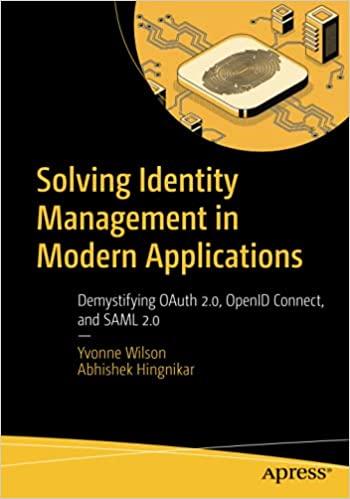Question
1.) Problem analysis involves all of the following EXCEPT: a. clarifying different perspectives b. determining the boundaries of the problem c. identifying and examining discrepancies
1.) Problem analysis involves all of the following EXCEPT:
a. clarifying different perspectives
b. determining the boundaries of the problem
c. identifying and examining discrepancies between goals and objectives
d. identifying insidious problems
2.) __________________convey the intent to improve the general operation of the organization.
a. Product objectives
b. Operational objectives
c. Impact objectives
d. Service objectives
3.) Contingency planning is like a game of______________. a. checkers
b. risk
c. chess
d. war
4.) Through______________, staff develops flexibility to experiment with new ventures.
a. measurable improvements
b. task assignment
c. pilot projects
d. urgent resolution
5.) Problem-solving criteria should be established as __________________against which to compare alternatives. They should encompass the organization's limits and expectations and likely vary according to the problem under consideration.
a. objectives
b. goals
c. benchmarks
d. strategy
6.) The theory of_________________, which has its roots in epidemiology, is based on the idea that when the beliefs and energies of a critical mass of people are engaged in an organization, conversion to a new idea will spread like an epidemic, bringing about fundamental change quickly.
a. natural inertia
b. effective impact
c. influencers
d. tipping points
7.) In_________________, the organization begins with the final result to be achieved and identifies the tasks that feed into activities by reviewing the question, "What must we do just before reaching our final result, and then what needs to be done before that, and before that, and so forth?" until the beginning point is reached)
a. forward-sequencing planning
b. reverse-order planning
c. strategic planning
d. long-range planning
8.) Effective managers use the opportunity of programming the strategic plan to determine whether adequate resources are available to properly complete the job or whether resources should be redeployed from low- to high-priority endeavors.
a. TRUE
b. FALSE
9.) Labeling the project a "crisis" focuses needed attention and rallies everyone to find a solution to a pressing problem. a. TRUE
b. FALSE
10.) The purpose of the training for successful pilot projects is to provide general information lectures.
a. TRUE
b. FALSE
11.) Operational objectives are essential to enhance the way an organization functions. They are a means to the end for which the organization was established.
a. TRUE
b. FALSE
12.) Most actions involve some degree of risk because their impact cannot fully be appreciated until they are actually implemented and because no one can predict the future with complete accuracy.
a. TRUE
b. FALSE
13.) Organizations typically develop impact, service, operational, and product objectives.
a. TRUE
b. FALSE
14.) Organizations, like individuals, tend to produce unintended compensatory responses when old efforts are tried.
a. TRUE
b. FALSE
15.) ____________________are defined as a measurable change in a client's life achieved between entry and exit of a program.
a. Throughputs
b. Outcome measures
c. Outputs
d. Resource inputs
16.) The term ____________is used as a metaphorical expression to convey the importance of treating people with care and dignity.
a. client
b. customer
c. service provider
d. consumer
17.) ____________________identifies various points along the process EXCEPT:
a. where activities need to be monitored for feedback
b. where different decisions have to be made
c. crucial decisions have to be made
d. where the budget needs to be revised
18.) The ___________________focuses on determining what consumers of services (the market) want and then how the agency can meet those needs.
a. strategic planning model
b. logic planning model
c. marketing planning model
d. consumer planning model
19.) The term ________________is sometimes used to describe this sequence of structured contacts with clients as they move through the service delivery system. Pathways can be either a single route or multiple routes.
a. outcome
b. output
c. pathway
d. throughput
20.) __________________are the first benefits clients experience and are the ones most closely related to a program's outputs.
a. Throughputs
b. Client outcomes
c. Outputs
d. Initial outcomes
21.) At the end of the program period, the agency provides a report comparing the projected outcomes with actual outcomes in an________________.
a. output review
b. outcome evaluation
c. output summary review
d. evaluation review
22.) Initial outcomes are final changes in participants' knowledge, attitudes, or skills, and they are necessary steps toward ultimate desired ends.
a. TRUE
b. FALSE
23.) Social systems analysis is a useful analytical framework for understanding how various parts within organizations effectively interact.
a. TRUE
b. FALSE
24.) The culture of caring permeates the entire organization as it continually reinforces this primary value in new policies, staff meetings, annual reports, training programs, and documents describing particular programs.
a. TRUE
b. FALSE
25.) Always assume that clients, even those who evidence strengths and competencies, can automatically connect their problems to your solutions.
a. TRUE
b. FALSE
26.) Experiencing the organization as a consumer can reveal discrepancies between how things should work and what actually takes place.
a. TRUE
b. FALSE
27.) Human service managers need to the client self-reported satisfaction scale exclusively as a substitute for more objective scales of outcomes.
a. TRUE
b. FALSE
28.) Everyone in the organization can be involved in a marketing effort to ascertain how consumers feel about their services & about the agency.
a. TRUE
b. FALSE
Step by Step Solution
There are 3 Steps involved in it
Step: 1

Get Instant Access to Expert-Tailored Solutions
See step-by-step solutions with expert insights and AI powered tools for academic success
Step: 2

Step: 3

Ace Your Homework with AI
Get the answers you need in no time with our AI-driven, step-by-step assistance
Get Started


